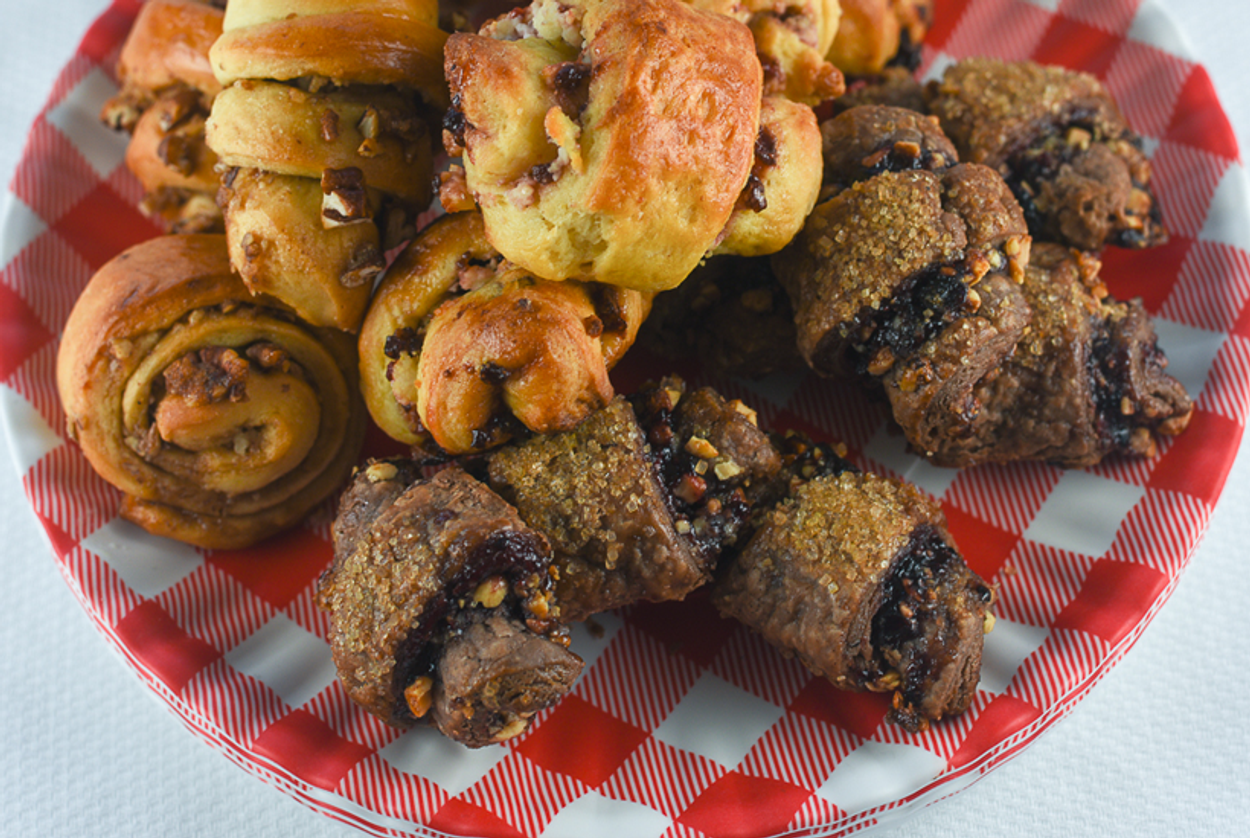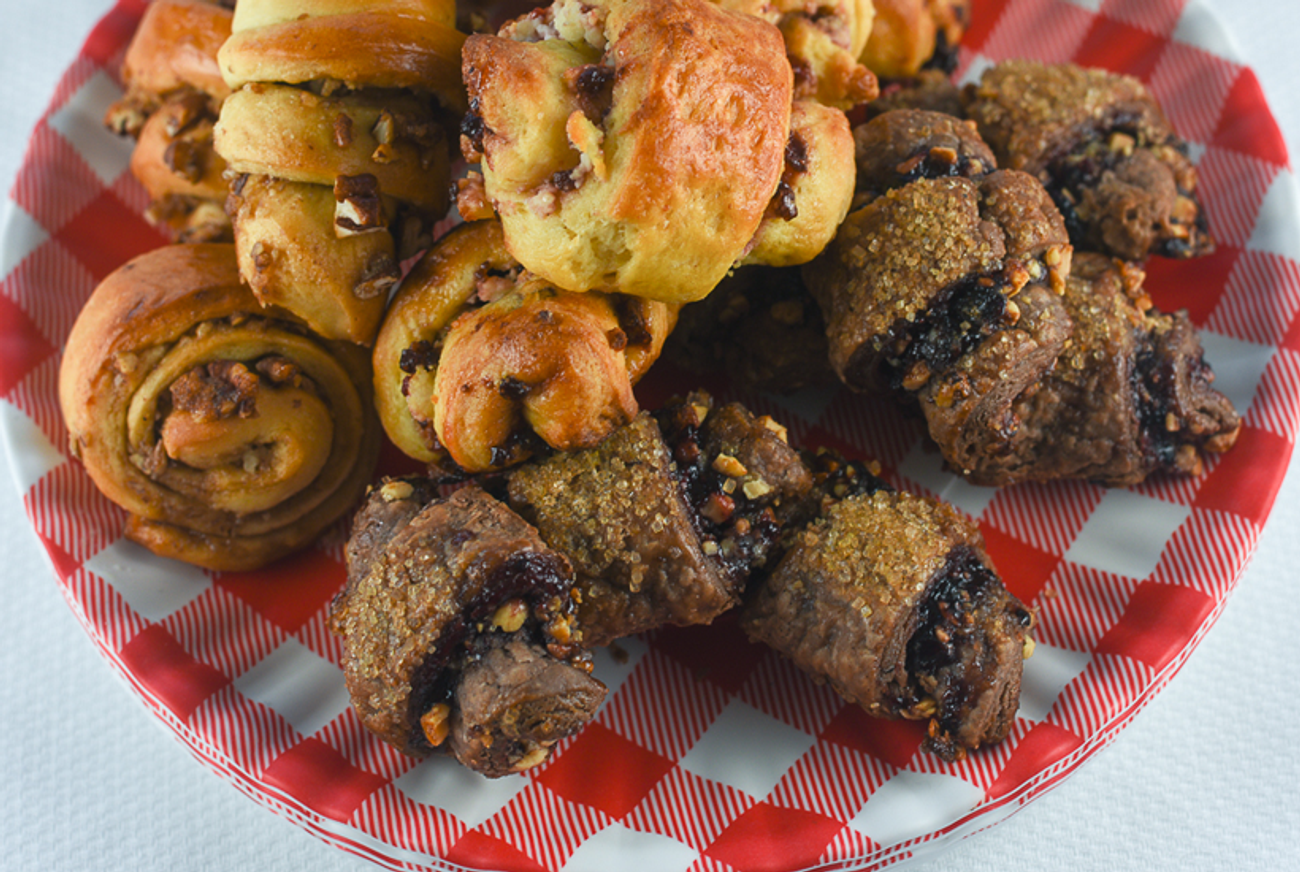Rugelach, an American Treat
While this rolled, filled cookie has its roots in Europe, the version you know and love is a New World creation




Rugelach. These crisp cookies rolled with dried fruits, nuts, or chocolate, conjure up images of bubbes in babushkas, carrying on the culinary traditions of their distant foremothers. But in fact, the rugelach you probably know and love are not an Old World treat that crossed the ocean generations ago. These rugelach are an American invention.
True, the recipe’s roots are European. Rugelach are likely the culinary descendant of kipfel, an Austro-Hungarian treat shaped like a triangular horn fashioned from a yeasted pastry. In Croatia, rolled pastries are called roski or roscici. The Czechs have their kolache, the Hungarians have their gyumolcskosarkak. And let’s not forget the chic-est of crescent-shaped pastries, the French croissant. So, it is fair to say that Europeans had rolled up pastries.
But the creation of rugelach, as we know them today—cookies made from yeast-free dough, rather than yeasted pastries—happened on this side of the Atlantic, less than a century ago, as a result of the commercialization of one of its key ingredients: cream cheese.
Fresh cheeses like German quark, or French-style Neufchatel had been occasionally worked into yeasted dough to provide tenderness. Alas, prior to refrigeration and refrigerated trucking, fresh cheeses had a very limited shelf life, so this benefit was limited to friends of European dairy farmers. Rabbi Jeffrey Marx, of Sha’ari Am of Santa Monica, California—an expert on the history of cream cheese and author of the article “The Days Had Come of Curds and Cream: The Origins and Development of Cream Cheese in America, 1870-1880,” in the journal Food, Culture and Society—traces its popularization to the late 19th century, when the addition of cream to more traditional fresh cheeses created a milder, more spreadable, consistent concoction. At the same time, advances in mass production, packaging, advertising, and transportation—particularly refrigerated transportation—made it easier to sate the public’s appetite far from the dairy farm.
In New York, cheesemaker William Lawrence, along with distributor Alvah Reynolds, eventually packaged small bricks of this cream cheese and named it “Philadelphia Brand Cream Cheese” because the city of Brotherly Love was, at the time, an epicenter for rich, pure dairy. Marx noted that it was like calling something champagne. This champagne of cream cheese was acquired by Kraft in 1928. Armed with its significant budget, the company trained its marketing savvy on the nation of Sinclair Lewis’ The Jungle, which wanted safe food. “Kraft makes this famous brand of cream cheese in a spotless plant near your home!” an early ad beamed. In addition to being hygienic, Philadelphia Brand cream cheese was also touted as nutritional. The Chicago Daily Tribune pronounced it “perfect for growing children.”
Cream cheese was also an affordable source of calories—a fact not lost when the nation skidded into the Great Depression. As increasing numbers of women began to work outside the home, recipes for simple dishes abounded, with cream cheese frequently playing a starring role. In the 1930s, Kraft introduced a cream cheese, yeast-free dough that was a time and labor saver.
By the time of the 1939 World’s Fair in New York City—advertised as “building the world of tomorrow, preserving the world of yesterday”—many homes in the United States had a refrigerator. And the dairy industry aimed to fill it. Kraft and Borden grabbed the opportunity to educate fairgoers about how to cook with their cream cheese by handing out color cookbooklets featuring recipes that would be tweaked and converted into Jewish American icons: New York-style cheesecake (then a pie) and for Kraft, cream cheese dough—then used in an unrolled, danish-style apricot tart.
Cream cheese quickly caught on with American Jews. In Inside the Jewish Bakery, Stanley Ginsburg and Norman Berg write that the “mild tasting, unripened, high-fat cheese took Yiddish cooking by storm.” Modern rugelach were soon born.
So, who made them first? There is no evidence that any commercial test kitchens produced the rolled, filled cookie we know using that cream cheese dough. Perhaps it was an enterprising greenhorn who added the newfangled cream cheese into the dough. Perhaps someone brought Kraft’s World’s Fair recipe into the kitchen and tweaked it. Whatever its provenance, in 1939 some Jewish bakeries—like those in Newark’s Third Ward—were offering rugelach, a rolled cookie with a cream cheese-based, yeast-free dough. It was an indisputably American invention.
The first recipe to appear under the nomenclature of rugelach was noted by food scholar Gil Marks in his Encyclopedia of Jewish Food: In 1941’s The Jewish Home Beautiful, Betty D. Greenberg and Althea O. Silverman wrote about dough “minus the bogey of countless hours of rising and endless kneading,” noting that the method “is quite modern.”
The cookie recipe invaded Jewish cookbookland. In 1946, food editor Regina Frishwasser included in her Jewish American Cookbook the version of rugelach most often seen today. Molly Goldberg offered basically same recipe in her 1955 book. Not everyone embraced the cookie. The Jewish Cookbook’s Mildred Goldberg Bellin slighted the cream cheese dough. But that didn’t stop the spread of rugelach. In 1960, when Borscht Belt hotelier Jenny Grossinger published her 1960 cookbook, rugelach had arrived. After that it was hard not to find a rugelach recipe—from Maida Heatter to Claiborne & Franey. Among Jews, rugelach developed a connection to Shavuot, when dairy foods are traditionally eaten. But non-Jews embraced rugelach, too: A&P branded rugelach as an ethnic, heritage cookie, a treasured recipe from the past.
That past was mostly imagined. These cookies, in their popular cream cheese-based form, remain distinctly American and modern. In Israel, for instance, rugelach are sold in budget bakeries and posh patisserie alike. But according to Israeli food expert Janna Gur, the Israeli version—in bakeries, or the home version—are made from laminated, yeasted dough, like a European pastry. The yeast-free, cream cheese version, she said, is American.
As American as rugelach, I say.
Tami Ganeles Weiser is a writer, food anthropologist, culinary educator, trained chef, corporate caterer, and recovering lawyer. She is a columnist for The Weiser Kitchen and ZesterDaily.com and contributes regularly to The Forward, The Nosher, Moment Magazine, and more.